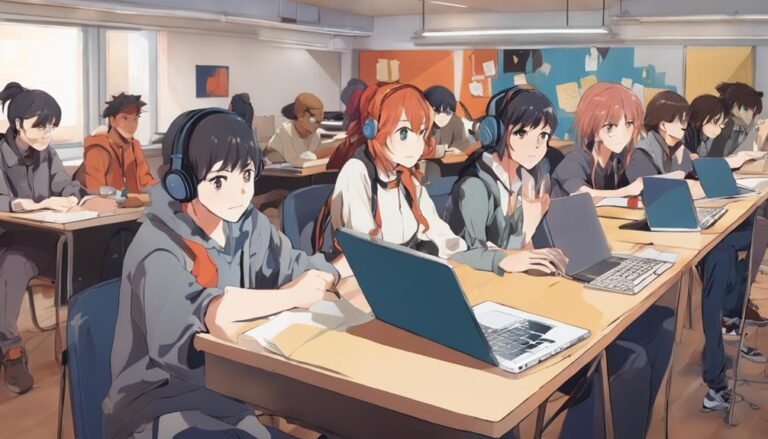How Can I Use Vr/Ar in My Online Courses?
You may be wondering how to incorporate VR/AR in your online courses to elevate the learning experience and engage your students in innovative ways. By integrating these technologies, you can transform abstract concepts into tangible experiences, offering a new dimension of learning that goes beyond traditional methods. So, how exactly can you leverage VR/AR to create dynamic and interactive virtual environments that captivate your students' attention and foster deeper understanding? Keep reading to explore practical strategies and best practices for implementing VR/AR effectively in your online courses.
Key Takeaways
- Enhance engagement with immersive VR/AR experiences.
- Provide hands-on learning opportunities in virtual environments.
- Foster critical thinking through interactive assessments.
- Create dynamic, interactive simulations for deeper understanding.
- Customize learning paths to cater to individual student needs.
Benefits of VR/AR in Online Courses
Enhancing engagement and retention, incorporating Virtual Reality (VR) and Augmented Reality (AR) technologies in online courses offers a dynamic learning experience for students. By immersing students in a simulated environment, these technologies provide a hands-on approach that fosters increased retention of course material.
One notable benefit of using VR/AR in online courses is the ability to create interactive assessments. Instead of traditional quizzes or exams, students can engage in virtual scenarios where they apply their knowledge in real-time. This not only tests their understanding but also enhances critical thinking and problem-solving skills. As a result, students are more likely to remember and apply what they've learned in practical situations.
Furthermore, interactive assessments through VR/AR make the learning process more engaging and enjoyable. Students are actively involved in their education, leading to a sense of ownership over their learning outcomes. This active participation can significantly boost motivation and overall performance in online courses.
Enhancing Student Engagement
By incorporating immersive learning experiences, you can transport students to virtual worlds where they can actively engage with the course material. Utilizing interactive virtual environments allows for a dynamic and personalized approach to learning, fostering deeper student involvement.
Engaging students in hands-on activities through VR/AR can greatly enhance their understanding and retention of complex concepts.
Immersive Learning Experiences
Immerse yourself in the world of virtual and augmented reality to elevate student engagement in online courses. By incorporating virtual simulations and interactive labs, you can provide students with hands-on experiences that enhance their understanding and retention of course material.
Experiential learning through VR/AR offers a unique opportunity for students to engage with the content in a more immersive and interactive way, fostering a deeper level of comprehension. Through sensory engagement, such as visual and auditory stimuli, learners can absorb information more effectively, making the learning process more engaging and memorable.
Utilizing immersive learning experiences in online courses can revolutionize the way students interact with course material, ultimately leading to increased motivation, participation, and overall academic success.
Interactive Virtual Environments
Step into the dynamic world of virtual reality and discover how interactive virtual environments greatly enhance student engagement in online courses. Virtual simulations and interactive assessments provide students with hands-on learning experiences, allowing them to apply theoretical knowledge in practical scenarios.
Through immersive storytelling, students are transported to different worlds where they can explore real-world applications of the course material. By engaging with interactive virtual environments, learners are motivated to actively participate, leading to a deeper understanding of the subject matter.
These environments offer a unique opportunity for students to interact with the content in a dynamic and engaging way, fostering critical thinking and problem-solving skills. Embracing interactive virtual environments can revolutionize online learning experiences, making education more interactive and engaging.
Engaging Hands-On Activities
Engaging students with hands-on activities in online courses fosters a deeper connection to the material and enhances overall learning outcomes. Incorporating interactive simulations and engaging activities provides students with a dynamic learning experience that goes beyond traditional methods.
Here are three ways hands-on activities can benefit your online courses:
- Hands-On Experiences: By participating in hands-on tasks, students actively apply theoretical knowledge, making learning more practical and engaging.
- Immersive Learning: Through immersive experiences like virtual labs or AR-enhanced field trips, students can explore concepts in a more interactive and memorable way.
- Real-World Application: Hands-on activities help bridge the gap between theory and practice, allowing students to see the relevance of course content in real-world scenarios.
Integrating such engaging activities can greatly enhance student engagement and comprehension in online courses.
Creating Immersive Learning Experiences
To enhance the online learning experience, consider incorporating virtual reality and augmented reality technologies to create dynamic and interactive educational environments. By integrating these tools, you can offer students immersive storytelling experiences that engage them in experiential learning. Through VR and AR, learners can step into virtual worlds where they actively participate in scenarios, enhancing their comprehension and retention of complex concepts.
Virtual collaboration becomes seamless as students can interact with each other and the content in real-time, fostering a sense of presence and shared exploration. Interactive simulations allow learners to apply theoretical knowledge in practical contexts, making the learning process more engaging and memorable. These technologies enable educators to design compelling learning experiences that cater to different learning styles and preferences.
Incorporating VR and AR into your online courses not only modernizes your teaching approach but also provides students with a more interactive and immersive educational journey, ultimately leading to enhanced learning outcomes.
Virtual Field Trips and Simulations
Consider immersing your online learners in engaging virtual field trips and simulations to enhance their educational experience. These tools can bring a whole new level of interactivity to your online courses, making learning more dynamic and memorable.
Here are some ways you can incorporate virtual field trips and simulations into your curriculum:
- Remote Collaboration: Utilize virtual field trips to promote remote collaboration among your students. They can explore various virtual environments together, fostering teamwork and communication skills.
- Interactive Workshops: Create interactive workshops within virtual simulations where students can apply their knowledge in practical scenarios. This hands-on approach can deepen their understanding of the subject matter.
- Virtual Experiments: Conduct virtual experiments to provide students with a safe environment to practice without the need for physical resources. This can be particularly useful for science and engineering courses.
Interactive Virtual Labs
Incorporate interactive virtual labs into your online courses to provide hands-on learning experiences for your students in a dynamic and engaging way. Virtual experiments and interactive simulations offer a unique platform for hands-on exploration, allowing students to conduct experiments and manipulate variables in a controlled environment. These labs can simulate real-world scenarios, giving students the opportunity to apply theoretical knowledge to practical situations. By engaging in these interactive activities, students can enhance their understanding of complex concepts and develop critical thinking skills.
Interactive virtual labs also promote active learning by encouraging students to explore and experiment at their own pace. Through engaging activities within these virtual environments, students can observe cause-and-effect relationships firsthand, leading to a deeper comprehension of the subject matter. Additionally, virtual labs provide a safe space for students to make mistakes and learn from them without real-world consequences. This hands-on approach fosters a sense of curiosity and discovery, making the learning process more enjoyable and memorable for students.
Customizing Learning Paths
You can revolutionize online learning by tailoring content to individual needs and preferences, providing personalized experiences that enhance engagement and comprehension.
With adaptive content delivery, students can progress at their own pace, receiving targeted materials that cater to their unique learning styles and abilities.
Personalized Learning Experiences
Exploring personalized learning experiences through customizing learning paths can greatly enhance student engagement and knowledge retention in online courses. When implementing these strategies, consider the following:
- Personalized Assessments: Tailoring assessments to each student's strengths and weaknesses can provide valuable insights into their progress.
- Virtual Tutoring: Offering one-on-one virtual tutoring sessions can provide personalized support and guidance to students who may need extra help.
- Interactive Simulations: Engaging students in interactive simulations can make learning more immersive and enjoyable, enhancing their understanding of complex concepts.
Adaptive Content Delivery
Customizing learning paths through adaptive content delivery is a key strategy to cater to individual student needs and enhance the online learning experience. By utilizing adaptive technology, online courses can offer personalized instruction that adjusts to each learner's pace and preferences.
This approach enables students to focus on areas where they need more help, accelerating their learning progress. Adaptive content delivery allows for dynamic adjustments in the course material based on a student's performance and engagement levels, providing a tailored learning experience.
Through interactive tools and real-time feedback, educators can guide students through customized learning paths that suit their learning styles, ultimately improving retention and comprehension in online courses.
Collaborative VR/AR Projects
Engaging in collaborative VR/AR projects enhances the interactive learning experience for online course participants. Virtual team building becomes more tangible as learners immerse themselves in shared virtual environments, fostering communication and teamwork skills. Collaborative design takes on a new dimension as students can co-create and manipulate 3D models or simulations in real-time, encouraging creativity and problem-solving.
Here are three key benefits of collaborative VR/AR projects:
- Enhanced Engagement: Working together in a virtual space increases motivation and engagement levels, leading to a more profound learning experience.
- Improved Communication: Participants can communicate more effectively through gestures, avatars, and spatial audio cues, enhancing collaboration and understanding.
- Real-world Application: By working collaboratively on VR/AR projects, learners can apply theoretical knowledge to practical scenarios, reinforcing key concepts in a meaningful way.
Incorporating collaborative VR/AR projects into online courses not only enriches the learning process but also cultivates essential skills for the modern digital age.
Assessing Student Progress
Moving from collaborative VR/AR projects to gauging student progress involves evaluating individual achievements and understanding the impact of immersive learning experiences in online courses. When appraising student performance in virtual reality (VR) and augmented reality (AR) settings, it's essential to implement effective assessment strategies that align with the unique nature of these technologies. One way to track progress is by analyzing how students interact with the virtual environment, measuring their engagement levels and problem-solving skills within these simulations.
Incorporating progress tracking tools within VR/AR platforms can provide valuable insights into students' comprehension and application of course material. These tools can capture data on students' actions, decisions, and responses, allowing instructors to tailor feedback and support accordingly. Additionally, utilizing analytics within VR/AR environments enables educators to identify areas where individual students may be struggling, facilitating targeted interventions to enhance learning outcomes.
Overcoming Challenges and Limitations
To effectively navigate the complexities of integrating VR/AR technology into online courses, educators must strategize innovative solutions to overcome the inherent challenges and limitations. When facing obstacles in technology adoption and instructional design, consider the following:
- Adaptation and Training: Providing adequate training for both educators and students on how to use VR/AR technology can help bridge the gap in technology adoption. Offering continuous support and resources for adapting instructional design to fit this new medium is important.
- Accessibility Considerations: Addressing accessibility concerns is essential to make sure all students can fully participate. Implement features such as closed captioning, audio descriptions, and alternative navigation methods to enhance the user experience for individuals with disabilities.
- User Experience Optimization: Prioritize enhancing the overall user experience by simplifying interfaces, optimizing content for VR/AR devices, and gathering feedback from students to continuously improve the learning environment. Aiming for seamless interaction and engagement will lead to more effective online courses.
Conclusion
To sum up, incorporating VR/AR in your online courses can revolutionize the learning experience for students. By providing immersive and interactive learning environments, you can enhance engagement, comprehension, and critical thinking skills.
For example, a study conducted at a university showed that students who participated in virtual field trips using VR technology demonstrated a deeper understanding of the subject matter compared to those who did not.
Embrace the power of VR/AR to take your online courses to the next level.







